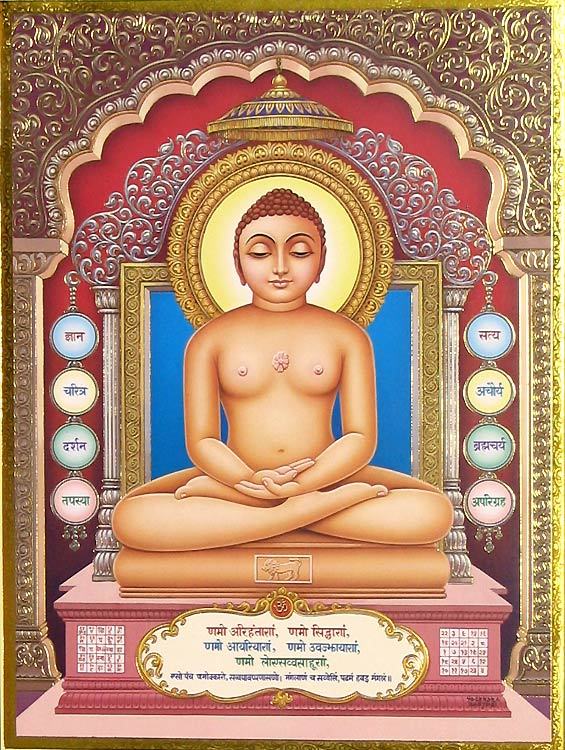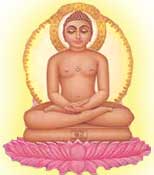Lord Mahavir and His Teachings
Lord Mahavir was the twenty-fourth and last Tirthankara of the Jain religion of this era. According to Jain philosophy, all Tirthankaras were human beings but they have attained a state of perfection or enlightenment through meditation and self realization. They are the Gods of Jains. The concept of God as a creator, protector, and destroyer of the universe does not exist in Jainism. Also the idea of God's reincarnation as a human being to destroy the demons is not accepted in Jainism.
Lord Mahavir was born on the thirteenth day of rising moon of Chaitra month, 2,593 years ago (599 B.C.) in Bihar, India. This day falls in the month of April as per English calendar. His birthday is celebrated as Mahavir Jayanti day.
Mahavir was a prince and was given the name Vardhaman by his parents. Being son of a king, he had many worldly pleasures, comforts, and services at his command. But at the age of thirty, he left his family and royal household, gave up his worldly possessions, and become a monk in search of a solution to eliminate pain, sorrow, and sufferings.
Mahavir spent the next twelve and half years in deep silence and meditation to conquer his desires, feelings, and attachments. He carefully avoided harming or annoying other living beings including animals, birds, and plants. He also went without food for long periods. He was calm and peaceful against all unbearable hardships that he was given the name Mahavir, meaning very brave and courageous. During this period, his spiritual powers fully developed and at the end he realized perfect perception, knowledge, power, and bliss. This realization is known as keval-jnana or the perfect enlightenment.
Mahavir spent the next thirty years travelling on bare foot around India preaching to the people the eternal truth he realized. The ultimate objective of his teaching is how one can attain total freedom from the cycle of birth, life, pain, misery, and death, and achieve the permanent blissful state of one's self. This is also known as liberation, nirvana, absolute freedom, or Moksha.
Mahavir explained that from eternity, every living being (soul) is in bondage of karmic atoms, that are accumulated by good or bad deeds. Under the influence of karma, the soul is habituated to seek pleasures in materialistic belongings and possessions. Which are the deep rooted causes of self-centered violent thoughts, deeds, anger, hatred, greed, and such other vices. These result in further accumulation of karmas.
Mahavir preached that right faith (samyak-darshana), right knowledge (samyak-jnana), and right conduct (samyak-charitra) together is the real path to attain the liberation of one's self. At the heart of right conduct for Jains lie the five great vows:
- Nonviolence (Ahimsa) - not to cause harm to any living beings
- Truthfulness (Satya) - to speak the harmless truth only
- Non-stealing (Asteya) - not to take anything not properly given
- Chastity (Brahmacharya) - not to indulge in sensual pleasure
- Non-possession/ Non-attachment (Aparigraha) - complete detachment from people, places, and material things
Jains hold these vows at the center of their lives. These vows cannot be fully implemented without the acceptance of a philosophy of non-absolutism (Anekantvad) and the theory of relativity (Syadvad). Monks and nuns follow these vows strictly and totally, while the common people follow the vows as far as their life styles will permit.
In the matters of spiritual advancement, as envisioned by Mahavir, both men and women are on an equal footing. The lure of renunciation and liberation attracted women as well. Many women followed Mahavir's path and renounced the world in search of ultimate happiness.
Thus, the principles of Jainism, if properly understood in their right perspective and faithfully adhered to, will bring contentment and inner happiness and joy in the present life. This will elevate the soul in future reincarnations to a higher spiritual level, achieving Perfect Enlightenment, reaching its final destination of Eternal Bliss, ending all cycles of birth and death.
Mahavir attracted people from all walks of life, rich and poor, kings and commoners, men and women, princes and priests, touchable and untouchable. He organized his followers, into a fourfold order, namely monk (Sadhu), nun (Sadhvi), layman (Shravak), and laywoman (Shravika). This order is known as Jain Sangh. Lord Mahavir's sermons were orally complied by his immediate disciples in Agam Sutras. These Agam Sutras were orally passed on to the future generations. In course of time many of the Agam Sutras have been lost, destroyed, or modified. About one thousand years later the Agam Sutras were recorded on Tadpatris (leafy paper that was used in those days to preserve records for future references). Swetambar Jains have accepted these Sutras as authentic version of His teachings while Digambar Jains use them as a reference.
At the age of 72 (527 B.C.), Lord Mahavir attained nirvan and his purified soul left his body and achieved complete liberation. He became a Siddha, a pure consciousness, a liberated soul, living forever in a state of complete bliss. On the night of his nirvan, people celebrated the Festival of Lights (Dipavali) in his honor. This is the last day of Hindu and Jain calendar year known as Dipavali Day.
Jainism existed before Mahavir, and his teachings were based on those of his predecessors. Thus, unlike Buddha, Mahavir was more of a reformer and propagator of an existing religious order than the founder of a new faith. He followed the well established creed of his predecessor Tirthankar Parshvanath. However, Mahavir did reorganize the philosophical tenets of Jainism to correspond to his times.
A few centuries after Mahavir's nirvana, the Jain religious order (Sangha) grew more and more complex. There were schisms on some minor points, although they did not affect the original doctrines as preached by Mahavir. Later generations saw the introduction of ritualistic complexities which almost placed Mahavir and other Tirthankars on the throne of Hindu deities.
Significant points of Teachings of Lord Mahavir:
- Mahavir made religion simple and natural, free from elaborate ritual complexities. His teachings reflected the internal beauty and harmony of the soul.
- Mahavir taught the idea of supremacy of human life and stressed the importance of the positive attitude of life.
- Mahavir's message of nonviolence (Ahimsa), truth (Satya), non-stealing (Achaurya), celibacy (Brahma-charya), and non-possession (Aparigraha) is full of universal compassion. He said that, "A living body is not merely an integration of limbs and flesh but it is the abode of the soul which potentially has perfect perception (Anant-darshana), perfect knowledge (Anant-jnana), perfect power (Anant-virya), and perfect bliss (Anant-sukha).
- Mahavir's message reflects freedom and spiritual joy of the living being.
- Mahavir emphasized that all living beings, irrespective of their size, shape, and form how spiritually developed or undeveloped, are equal and we should love and respect them. This way he preached the gospel of universal love.
- Mahavir rejected the concept of God as a creator, a protector, and a destroyer of the universe. He also denounced the worshiping of gods and goddesses as a means of material gains and personal benefits.

Prayer of Jain religion:
Every day Jains bow their heads and say their universal prayer, the Navkar-mantra. All good work and events start with this prayer of salutation and worship.
Namo Arihantanam
I bow to the enlightened beingsNamo Siddhanam
I bow to the liberated soulNamo Ayariyanam
I bow to religious leadersNamo Uvajjayanam
I bow to religious teachersNamo Loe Savva Sahunam
I bow to all ascetics of the worldEso Panch Namukkaro
Savva Pava Panasano
Mangalancha Savvesin
Padhamam Havai MangalamThese five salutations are capable of destroying all the sins and this is the first happiness among all forms of happiness.
In the above prayer, Jains salute the virtues of their five benevolent. They do not pray to a specific Tirthankara or monk by name. By saluting them, Jains receive the inspiration from the five benevolent for the right path of true happiness and total freedom from the misery of life. Jain prayers do not ask for any favors or material benefits from their Gods, the Tirthankaras or from monks and nuns.
The Antiquity of Jainism:
Jain religion and its philosophy is as old as Vedic (Hindu) religion or probably the oldest living religion of India. The ancient Hindu, Budhhist, and Jain scriptures indicate that the religion began as a spiritual discipline for Samans. The propounders of this tradition modified the philosophical tenets according to their time, place and circumstances. The name Jain is a relatively new.
The Samans were also known as Arhats, Tirthankars, Nirganths, Arihants, or Jinas:
Later on the religion propounded by such conquerors is called the Jainism and the followers are known as Jains. There are references to the Jain Tirthankars, Samans, and Arhats, and their ethical principles in the Hindu (Vedic) literature Rigveda, Yajurveda, and Puranas.
According to Sarvepalli Radhakrishnan (former president of India):
"Jaina tradition ascribes the origin of the system to Rsabhadeva who lived many millennia back. There is evidence to show that as far back as the first century B.C. there were people who were worshipping Rsabhadeva, the first Tirthankara. There is no doubt that Jainism prevailed even before Vardhamana (Mahavir) or Parsvanatha."
The Yajurveda mentions the names of three Tirthankaras; Rsabha, Ajita, and Aristanemi. The Bhagvata Purana endorses the view that Rsabhadeva was the founder of Jainism.
The images, seals, and other findings amongst the discoveries at Harappa and Mohenjodara, and some earlier inscriptions of ancient India also lend support to the view that Rsabhadeva was the founder of Jainism, which was non-Vedic in origin and probably pre-Aryan.
Scholars have examined these sources and have concluded that these personalities must be pre-Vedic and that the religion they preached must have preceded the Vedic religion.
 Pravin K. Shah
Pravin K. Shah
